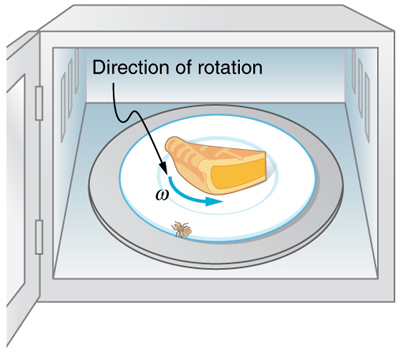| << Chapter < Page | Chapter >> Page > |
Large freight trains accelerate very slowly. Suppose one such train accelerates from rest, giving its 0.350-m-radius wheels an angular acceleration of . After the wheels have made 200 revolutions (assume no slippage): (a) How far has the train moved down the track? (b) What are the final angular velocity of the wheels and the linear velocity of the train?
Strategy
In part (a), we are asked to find , and in (b) we are asked to find and . We are given the number of revolutions , the radius of the wheels , and the angular acceleration .
Solution for (a)
The distance is very easily found from the relationship between distance and rotation angle:
Solving this equation for yields
Before using this equation, we must convert the number of revolutions into radians, because we are dealing with a relationship between linear and rotational quantities:
Now we can substitute the known values into to find the distance the train moved down the track:
Solution for (b)
We cannot use any equation that incorporates to find , because the equation would have at least two unknown values. The equation will work, because we know the values for all variables except :
Taking the square root of this equation and entering the known values gives
We can find the linear velocity of the train, , through its relationship to :
Discussion
The distance traveled is fairly large and the final velocity is fairly slow (just under 32 km/h).
There is translational motion even for something spinning in place, as the following example illustrates. [link] shows a fly on the edge of a rotating microwave oven plate. The example below calculates the total distance it travels.

A person decides to use a microwave oven to reheat some lunch. In the process, a fly accidentally flies into the microwave and lands on the outer edge of the rotating plate and remains there. If the plate has a radius of 0.15 m and rotates at 6.0 rpm, calculate the total distance traveled by the fly during a 2.0-min cooking period. (Ignore the start-up and slow-down times.)
Strategy
First, find the total number of revolutions , and then the linear distance traveled. can be used to find because is given to be 6.0 rpm.
Solution
Entering known values into gives
As always, it is necessary to convert revolutions to radians before calculating a linear quantity like from an angular quantity like :
Now, using the relationship between and , we can determine the distance traveled:
Discussion
Quite a trip (if it survives)! Note that this distance is the total distance traveled by the fly. Displacement is actually zero for complete revolutions because they bring the fly back to its original position. The distinction between total distance traveled and displacement was first noted in One-Dimensional Kinematics .
Rotational kinematics has many useful relationships, often expressed in equation form. Are these relationships laws of physics or are they simply descriptive? (Hint: the same question applies to linear kinematics.)
Rotational kinematics (just like linear kinematics) is descriptive and does not represent laws of nature. With kinematics, we can describe many things to great precision but kinematics does not consider causes. For example, a large angular acceleration describes a very rapid change in angular velocity without any consideration of its cause.
With the aid of a string, a gyroscope is accelerated from rest to 32 rad/s in 0.40 s.
(a) What is its angular acceleration in rad/s 2 ?
(b) How many revolutions does it go through in the process?
(a)
(b) 1.0 rev
Suppose a piece of dust finds itself on a CD. If the spin rate of the CD is 500 rpm, and the piece of dust is 4.3 cm from the center, what is the total distance traveled by the dust in 3 minutes? (Ignore accelerations due to getting the CD rotating.)
A gyroscope slows from an initial rate of 32.0 rad/s at a rate of .
(a) How long does it take to come to rest?
(b) How many revolutions does it make before stopping?
(a) 45.7 s
(b) 116 rev
During a very quick stop, a car decelerates at .
(a) What is the angular acceleration of its 0.280-m-radius tires, assuming they do not slip on the pavement?
(b) How many revolutions do the tires make before coming to rest, given their initial angular velocity is ?
(c) How long does the car take to stop completely?
(d) What distance does the car travel in this time?
(e) What was the car's initial velocity?
(f) Do the values obtained seem reasonable, considering that this stop happens very quickly?

Everyday application: Suppose a yo-yo has a center shaft that has a 0.250 cm radius and that its string is being pulled.
(a) If the string is stationary and the yo-yo accelerates away from it at a rate of , what is the angular acceleration of the yo-yo?
(b) What is the angular velocity after 0.750 s if it starts from rest?
(c) The outside radius of the yo-yo is 3.50 cm. What is the tangential acceleration of a point on its edge?
a)
b) 450 rad/s
c) 21.0 m/s

Notification Switch
Would you like to follow the 'College physics for ap® courses' conversation and receive update notifications?